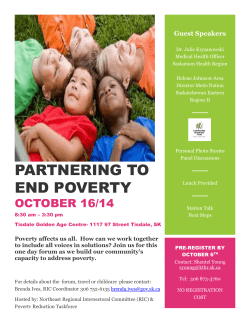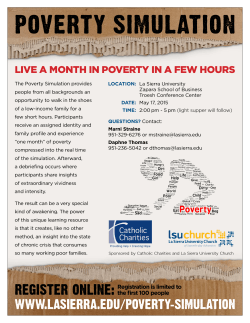
Racial disparities in clinical outcomes: Is racism a missing piece of
CENTER ON SOCIAL DISPARITIES IN HEALTH University of California, San Francisco Racial disparities in clinical outcomes: Is racism a missing piece of the puzzle? GME Grand Rounds UCSF March 17, 2015 Paula Braveman, MD, MPH Professor of Family & Community Medicine Director, Center on Social Disparities in Health University of California, San Francisco More health care spending but less health: Life expectancy 1 2 3 4 5 6 7 8 9 10 11 12 13 14 15 16 17 18 19 20 21 22 23 24 25 26 Japan (82.3 years) Australia Canada Spain Sweden/Switzerland Israel Iceland New Zealand Italy Norway Ireland United Kingdom Greece Austria Netherlands Luxembourg Germany Belgium Finland Korea Denmark Portugal United States (78.2 years) Chile Slovenia Czech Republic Source: CIA: The World Factbook online, January 2011 (2010 estimate). Higher income (or education), longer life Life expectancy at age 25 60 55 Family Income: 58.2 Percent of Federal Poverty Level ≤100% FPL 56.5 53.5 101-200% FPL 201-400% FPL 401%+ FPL 54.5 51.1 51.5 50 47.7 45.5 45 40 Men Women Analyses by Braveman et al. of National Longitudinal Mortality Study, 1988-98. Parents’ income (& education) shapes child health: Poor/fair child health reported by parent % of children age 0-17 years with poor/fair health 6 Family Income (Percent of Federal Poverty Level) 5 <100% FPL 100%-199% FPL 200-299% FPL 300-399% FPL ≥400% FPL 4.3 4 3 2.4 2 1.4 1 1.0 0.6 0 Family Income (% of Federal Poverty Level) Analyses by Braveman et al. of National Health Interview Survey (NHIS) 2001-2005, Age-adjusted Higher income (or education), better adult health (self-reported) % of adults aged ≥25 years with self-reported poor/fair health 35 Family Income 30.9 (Percent of Federal Poverty Level) 30 <100% FPL 100%-199% FPL 200-299% FPL 300-399% FPL ≥400% FPL 25 21.2 20 15 10 14.0 10.1 6.6 5 0 Family Income (% of Federal Poverty Level) Age-adjusted analyses by Braveman et al., of National Health Interview Survey (NHIS) 2001-2005. Racial/ethnic differences do not explain differences in adult health by income Family Income: % of adults age ≥25 years with self-reported poor/fair health 40 Percent of Federal Poverty Level <100% FPL 100%-199% FPL 200-299% FPL 300-399% FPL ≥400% FPL 35 30 25 20 15 10 5 0 Black, Non-Hispanic Hispanic White, Non-Hispanic Racial or Ethnic Group Age-adjusted analyses by Braveman et al. NHIS 2001-2005 Racial/ethnic differences do not explain adult health differences by education Educational attainment %of adults age ≥25 years with self-reported poor/fair health 40 Less than high school High school graduate Some college College graduate 35 30 25 20 15 10 5 0 Black, NonHispanic Hispanic Asian Pacific Islander American Indian, Alaska Native White, NonHispanic Age-adjusted analyses by Braveman, Egerter et al. of BRFSS 2009, Both race and socioeconomic factors matter: Self-reported adult health % of adults age ≥25 years with self-reported poor/fair health 40 35 Black, Non-Hispanic 30 White, Non-Hispanic Hispanic 25 20 15 10 5 0 <100% 100%-199% 200-299% 300-399% ≥400% Family Income (% of Federal Poverty Level) Braveman et al. analyses of NHIS 2001-2005. Age-Adjusted. How could income (or wealth) affect health? Income can shape: • Medical care • Nutrition & physical activity options • Housing & neighborhood conditions • Services Which can affect: • Stress • Family stability Parents’ income shapes offspring’s: • Education • Occupation • Income • Work conditions CENTER ON SOCIAL DISPARITIES IN HEALTH University of Calif ornia, San Francisco The stress-health link: Biologically plausible? Advances in neuro-science & psycho-neuro-immunology help elucidate how social factors like income and education “get into the body” & lead to chronic disease HPA axis, sympathetic nervous system, and immune/inflammatory mechanisms have been demonstrated as responses to stress — Relative importance of specific mediators (e.g., cortisol, ANS, cytokines, telomerase) not established Chronic stress is a plausible and likely major contributor to both the socioeconomic gradient and racial/ethnic inequalities in health How could stress affect health? STRESSOR Hypothalamus CRH Pituitary Gland ACTH Adrenal Glands CORTISOL DAMAGE TO MULTIPLE ORGANS & SYSTEMS chronic disease, immune suppression, inflammation Source: Center on Social Disparities in Health, UCSF. Less income, more stressors. Separation or divorce during pregnancy (similar patterns for 11 major stressors) % of women separated or divorced during pregnancy 15 Family Income: Percent of Federal Poverty Level ≤100% 12.7 12 101-200% 201-300% 9 301-400% 7.0 >400% 6 3.6 3 3.0 1.2 0 Family Income (% of Federal Povery Level) Braveman et al., analyses of CA Maternal & Infant Health Assessment 2003-2006. 13 Education can shape health behaviors by determining knowledge and skills Educational attainment •Health knowledge •Literacy •Problemsolving •Coping skills •Diet •Exercise •Smoking •Health/disease management Other plausible pathways from education to health, e.g., via work & income Income Educational attainment Work Neighborhood environment Diet & exercise options Stress Workrelated resources Health insurance Sick leave Wellness programs Stress Working conditions Control / demand imbalance Stress HEALTH Psychosocial pathways from education to health Social standing Educational attainment Social networks Control beliefs (powerlessness, sense/locus of control, fatalism, mastery) Social & economic resources Perceived status Stress Social & economic resources Norms Social support Stress Coping Response to stressors HEALTH CENTER ON SOCIAL DISPARITIES IN HEALTH University of Calif ornia, San Francisco Childhood socioeconomic conditions shape adult health Adult health is shaped by early experiences Lasting effects of in utero/early childhood deprivation, e.g., – low SES in adulthood (by limiting education) – May neuro-endocrine or immune dysregulation – Early childhood socioeconomic conditions could have crucial effects not erased by later circumstances Chronic stress/deprivation in childhood chronic disease in childhood and adulthood Cumulative effects of disadvantage CENTER ON SOCIAL DISPARITIES IN HEALTH University of Calif ornia, San Francisco Structural racial bias transmits socioeconomic disadvantage across generations The legacy of (once-legal) discrimination: Lower incomes, wealth, education, occupations And, at a given income or educational level, African Americans and Latinos on average: Have far less wealth Live in under-resourced, often unhealthier neighborhoods Were worse off in childhood More hardship with fewer resources to cope Rarely measured but studies often conclude a racial difference is genetic if it persists after “control for SES” – Race often captures unmeasured socioeconomic factors – – – – – Unmeasured socioeconomic differences could increase African Americans’ risk of ill health Racial segregation Pollution, toxins, crime No safe places to exercise Pervasive unhealthy food Ads for harmful substances Social networks & support Norms, role models, peers Poor access to jobs lower income, less wealth financial hardship stress, hopelessness Poor quality schools Blacks tracked into poorer neighborhoods than Whites of similar income Image: Dan Loh/AP And direct psychological effects of racism-related stress? Overt or subtle incidents Constant vigilance, fears about loved ones Chronic stress increases risk for chronic disease through HPA axis activation inflammation, immune dysregulation (e.g., via cortisol, CRH, ANS, cytokines, prostaglandins…) Both race & SES matter: Image: http://www.empowermagazine.com/how-racism-affects-your-health/ Racism low SES Race -- or racism? Improving health & reducing disparities by addressing the role of social factors like racism and poverty Policies to promote economic development, reduce poverty, and reduce racial segregation Economic & Social Opportunities and Resources Policies to promote child and youth development and education, infancy through college Living & Working Conditions in Homes and Communities Policies to promote healthier homes, neighborhoods, schools and workplaces Behaviors Medical Care Biology & Interactions between biology and experiences HEALTH Adapted from Braveman et al., Robert Wood Johnson Foundation Commission to Build a Healthier America | www.commissiononhealth.org
© Copyright 2025










